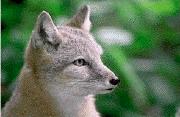

Common Names: Cosac
Fox, Steppe Fox
Genus:Vulpes
Species: corsac

The Corsac fox is a long legged, reddish gray fox with large ears and a short, pointy face. Its coat is grayish-red with silver undertones, and the under parts are white with yellow undertones. Its chin is also white. They have small teeth compared to other foxes. The Corsac Fox is slightly smaller than the red fox, about 50-60 cm, and as tall as an average sized dog.
Corsac foxes like to live in burrows on steppes and semi-deserts, and are originally from the steppes of Mongolia. You would not find them in areas that are used for agriculture. They are omnivorous so they eat small animals, birds, reptiles, insects and plants. They have some competition in getting their food, but they're good hunters.
The corsac fox is found throughout the southeast area of the former USSR and a large area of central Asia. They are also found in Turkestan, Afghanistan, Mongolia, Transbaikalia, and northern Manchuria.
Corsac fox mate between January and March with a gestation time that lasts 50-60 days. Typically between 2 and 6 young are born at a time, but there are some reported cases of a litter of up to 11 young. It is thought that the dog fox probably helps rear young but this is not known for certain. Males will fight with one another during the breeding season but then remain with the family pack. They live for 3 to 12 years.
They are more social than other foxes and some Corsac foxes go with others in burrows and form hunting packs. They can hear, smell and see very well. The hardest way for the Corsac Fox to escape an enemy is to run, because they run so slowly that a slow dog could catch them. They don't seem to have a home range that they protect from other foxes and migrate south when the food gets scarce.
The Corsac Foxes are not well spread around the steppe. Although hunting by humans has eliminated large groups, there are no conservation program for the Corsac Fox. Very little is known about the Corsac Fox but hunting and the plowing of land have significantly reduced their numbers. The fox has disappeared over much of its range.
Chantal G. 2000.
Bibliography:
"Gerbil, Fox and Falcon", New Standard Encyclopedia. Version 6.
"Corsac Fox",
http://www.dt.colorado.edu/~micucci/foxinfo.html,
(June, 2000).
"Cosac Fox (Vulpus
Corsac)",
http://www.canids.org/SPPACCTS/vcorsac.htm